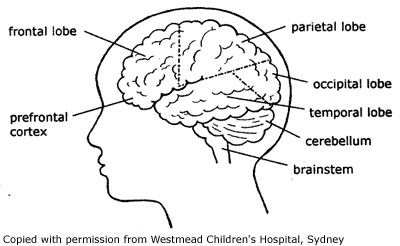The brain is made up of
different parts including the cerebrum, the cerebellum and the
brain stem. The effects of a brain injury will depend on which part of
the brain has been damaged, the severity of the injury and the age and stage of development of the child.
Parts of the
brain
Nerve cells in the brain
send and receive electrical impulses to and from the body. If you
take a close look at the human brain, you'll find it has three main
parts.
The largest is the
cerebrum on top. The surface of the cerebrum is
called the cerebral cortex. Although less than 0.5cm thick, the
cerebral cortex is critical to your child's ability to move, to
understand what they see and hear and to think - a complex
process of making decisions, learning, remembering and
planning.
The cerebrum is divided
into two halves called hemispheres. The corpus callosum is an
'electric highway' of nerve fibres which connects the two
hemispheres and allows information to pass between. The hemispheres are divided into smaller parts: the
frontal, temporal, parietal and occipital lobes.
At the back of your brain
and beneath the cerebral cortex is the cerebellum.
The cerebellum coordinates skilled movement, giving your child the ability to
walk without stumbling and to use their hands smoothly and
precisely.
Located at the base of the
brain is the brain stem, a stalk-like structure
that connects the brain to the spinal cord. The brain stem takes care of
basic and involuntary functions such as breathing, blinking and bowel
regulation.

Figure 1 The Brain
Areas
What are the effects of
injury to the different areas of the brain?
In focal brain injury, just
one lobe in one hemisphere may be affected. In diffuse injury, all
lobes of both hemispheres may be affected. There are
connections between the different areas of the brain, and damage to
one area may result in dysfunction associated with other parts of
the brain.
Frontal lobes
The frontal system controls
many complex functions, which are referred to as executive
functions. These include planning, control of impulses, initiation,
attention and emotion. The back of the frontal lobe also controls
movement of the opposite side of the body. Damage to the frontal
system (that is, damage to the frontal lobes directly or to the connections
to the frontal lobe) may cause changes in behaviour, attention,
emotions and also weakness to the opposite side of the
body.
Parietal lobes
The parietal lobes provide
sensory information to the brain including touch, pain and
temperature. Damage may cause the child to lose sensation down the
opposite side of the body. This may result in the child being less
aware of parts of their body. This is known as sensory neglect.
Temporal lobes
The functions of the
temporal lobes include hearing, memory and learning. Damage may
cause difficulties with organising what to say, and finding and
using the correct words. It may also result in difficulties with
short-term memory.
Occipital
lobes
The occipital lobes help us
understand what we see. They interpret the colour, shape and
distance away of what we look at. Damage may result in a distortion of
what is seen and difficulty recognising or interpreting familiar
objects.
Cerebellum
Damage to this area may
result in movement becoming jerky or uncoordinated and is known as
cerebellar ataxia. The child's speech may also become slurred and
difficult to understand. The cerebellum has rich connections to the
cerebrum. Therefore, damage to the cerebellum can result in
disruption to some of the functions controlled by other parts of the
brain.
Key points to
remember
- The central nervous system is made up of the
brain, the brain stem, the cerebellum and spinal cord.
- There are different areas of the brain
including the frontal, parietal, temporal and occipital
lobes.
- The effects of brain injury will depend on
what part of the brain, and/or which connections to an area within the
brain are damaged.
- Functions that are controlled by one part of
the brain can be disrupted when connections to it are damaged due
to brain injury.
For more
information
Developed by The Royal Children's
Hospital Paediatric Rehabilitation Service based on information from the Brain
Injury Service at Westmead Children’s Hospital. We acknowledge the input of RCH
consumers and carers.
Reviewed September 2020.
Kids Health Info is supported by
The Royal Children’s Hospital Foundation. To donate, visit www.rchfoundation.org.au.